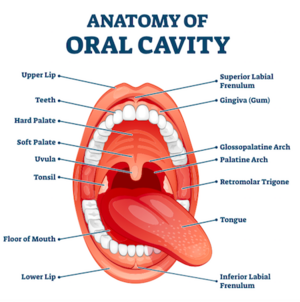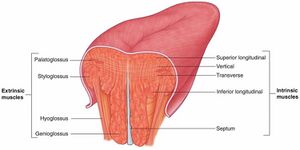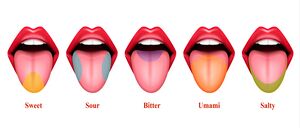Tongue
This article is currently under review and may not be up to date. Please come back soon to see the finished work! (13/01/2022)
Original Editor - User Name
Top Contributors - Shreya Trivedi and Oyemi Sillo
Description[edit | edit source]
The tongue is a oval shaped, Pink ,Moist ,Solid Conical, muscular organ, which is situated in a hollow cavity of mouth. As seen in the diagram it has various structure around and several attachments. It moves freely from the anterior side which not directly attached to any other structure. Posterior part of the tongue is attached to numerous structures thus why Tongue plays several important roles such as facilitation of gustatory stimuli, facilitates mastication, speech pathway, as it helps with articulation.[1][2]
Anatomical Relationships[edit | edit source]
- Anterior and lateral - teeth
- Superior - hard and soft palates
- Inferior - mucosa of the floor of the oral cavity, sublingual salivary glands, posterior wall of oropharynx
- Posterior - epiglottis, pharyngeal inlet
- Lateral - palatoglossal and palatopharyngeal arches[2]
The mylohyoid muscle, which is responsible for raising the body of the tongue in high vowels and velar consonants. The hyoglossus, which pulls it downwards (and slightly backwards). The styloglossus, which pulls the tongue upwards and backwards. The genioglossus, which forms the bulk of the inferior part of the tongue and pulls the body of the tongue forwards.
Muscles[edit | edit source]
Tongue is made of 2 main types of group of muscles that are Intrinsic group and Extrinsic group of muscles
Total 4 types of Intrinsic muscle
- The superior longitudinal lingual muscle, which shortens the tongue and curls it upward.
- The inferior longitudinal lingual muscle, which shortens the tongue and curls it downward.
- The transverse lingual muscle, which elongates and narrows the tongue.
- The vertical lingual muscle,which flattens the tongue
The extrinsic muscles are
- The genioglossus muscle protrudes the tongue
- The hyoglossus muscle depresses and retracts the tongue
- The styloglossus muscle draws up the sides of the tongue to create a trough for swallowing following adequate mastication. The pair of styloglossus muscles work together on each side to retract the tongue.
- The palatoglossus muscle, which elevates the posterior tongue, closes the oropharyngeal isthmus, aids in the initiation of swallowing, and prevents the spill of saliva from the vestibule into the oropharynx by maintaining the palatoglossal arch.
Function[edit | edit source]
Tongue plays several roles in taste, speech, swallowing in oral cavity.
1. Function of Taste(Gustation): Taste buds situated in the tongue plays role in taste identification. Taste receptors identify taste in 5 category Sweet, Sour, Salty, Bitter, and Umami.[3]
2. Function of Speech(Phonation): tongues movement against teeth, palate and within oral cavity helps in productions of speech
3. Swallowing and food manipulation(Deglutition): food manipulation occurs in oral cavity, tongue presses food against hard palate and enables mastication, forms the food bolus and promotes swallowing. [4][3][5]
Nerve[edit | edit source]
The motor supply of all Intrinsic as well as extrinsic muscles id done by cranial nerve XII (Hypoglossal) except one which is palatoglossus. Palatoglossus is supplied by Cranial nerve X (Vagus)[1][6]
Sensory supply of tongue
- Taste sensation of anterior two third- chorda tympani (branch of facial nerve), general sensation of the same by lingual nerve(branch of trigeminal nerve)
- Taste sensation and general sensations of posterior two third is supplied by glosspharangeral nerve
- Perception taste is also partly performed by epiglottis and epiglottic regions. Taste and general sensation is provided by the internal laryngeal branch of vagus nerve. [1][2][6]
Blood Supply[edit | edit source]
Blood supply to the tongue is predominantly from the lingual artery, a branch of the external carotid artery between the superior thyroid artery and the facial artery[4][5]
Clinical relevance[edit | edit source]
Assessment[edit | edit source]
Treatment[edit | edit source]
Links[edit | edit source]
In the video entitled Surface anatomy of the tongue (preview) - Human Anatomy and muscles of tongue by Kenhub the overview of Anatomy of tongue is explained. For further understanding of muscles of tongue and movements of tongue this cane be also an helpful watch.
Resources[edit | edit source]
- ↑ 1.0 1.1 1.2 Dotiwala AK, Samra NS. Anatomy, Head and Neck, Tongue. [Updated 2021 Apr 19]. In: StatPearls [Internet]. Treasure Island (FL): StatPearls Publishing; 2021 Jan-. Available from: https://www.ncbi.nlm.nih.gov/books/NBK507782/
- ↑ 2.0 2.1 2.2 Tongue [Internet]. Kenhub. 2022 [cited 7 January 2022]. Available from: https://www.kenhub.com/en/library/anatomy/tongue
- ↑ 3.0 3.1 AlJulaih G, Lasrado S. Anatomy, Head and Neck, Tongue Taste Buds [Internet]. Ncbi.nlm.nih.gov. 2022 [cited 7 January 2022]. Available from: https://www.ncbi.nlm.nih.gov/books/NBK539696/
- ↑ 4.0 4.1 The tongue: structure and function relevant to disease and oral health. SADJ. 2003;58(9):375-383.
- ↑ 5.0 5.1 FUCCI D, PETROSINO L. The Human Tongue: Normal Structure and Function and Associated Pathologies. Speech and Language. 1981;:305-374.
- ↑ 6.0 6.1 Mu L, Sanders I. Human tongue neuroanatomy: Nerve supply and motor endplates. Clinical Anatomy. 2010;23(7):777-791.









